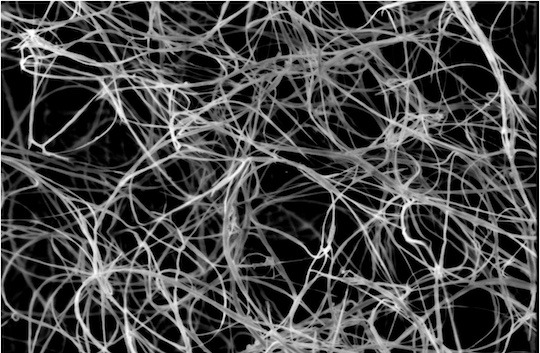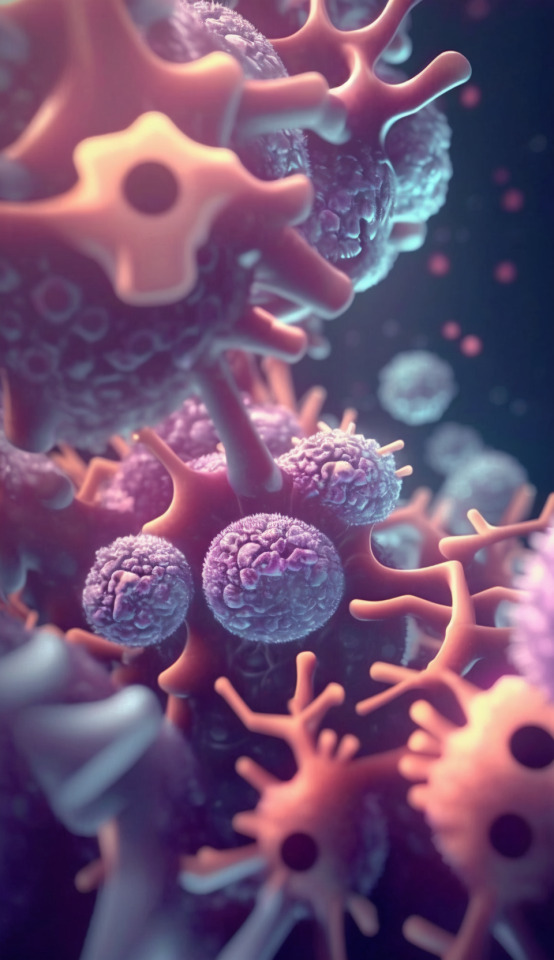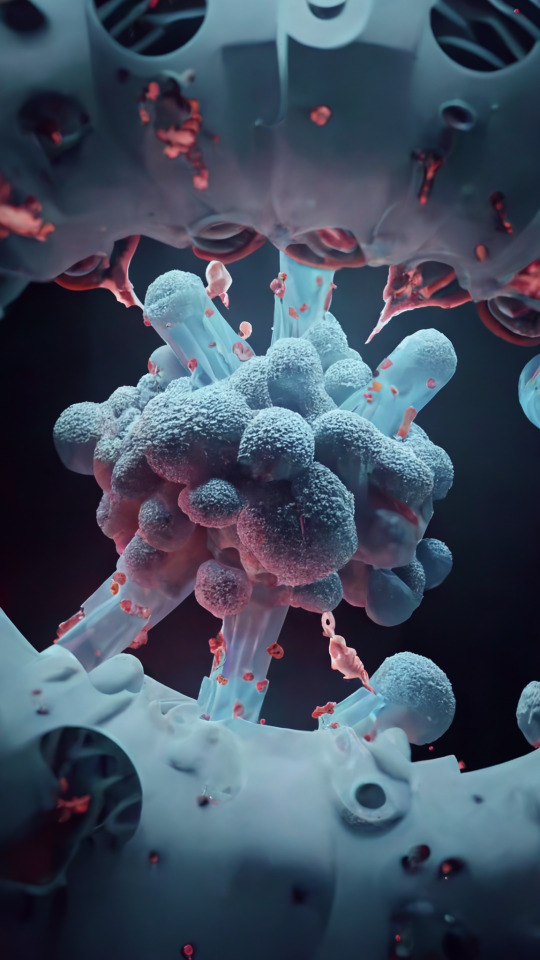#nanomaterials
Text
As summer turns to fall, many people will be turning off the air conditioning and firing up heaters instead. But traditional heating and cooling systems are energy-intensive, and because they typically run on fossil fuels, they aren't sustainable. Now, by mimicking a desert-dwelling chameleon, a team reporting in Nano Letters has developed an energy-efficient, cost-effective coating. The material could keep buildings cool in the summers—or warm in the winters—without additional energy.
Many desert creatures have specialized adaptations to allow them to survive in harsh environments with large daily temperature shifts. For example, the Namaqua chameleon of southwestern Africa alters its color to regulate its body temperature as conditions change. The critters appear light gray in hot temperatures to reflect sunlight and keep cool, then turn a dark brown once they cool down to absorb heat instead.
This unique ability is a naturally occurring example of passive temperature control—a phenomenon that could be adapted to create more energy-efficient buildings. But many systems, such as cooling paints or colored steel tiles, are only designed to keep buildings either cool or warm, and can't switch between "modes."
Inspired by the Namaqua chameleon, Fuqiang Wang and colleagues wanted to create a color-shifting coating that would adapt as outside temperatures fluctuate.
Continue Reading
114 notes
·
View notes
Text
Rice University's Pioneering Research in Boron Nitride Nanotubes - Potential to fundamentally transform a multitude of industries - Hydrogen Storage and Spacecraft Manufacturing Among Them
Researchers at Rice University, under the guidance of Professor Angel Martí, have made a significant breakthrough in the field of material science by developing a novel method to create high-purity boron nitride nanotubes.
These nanotubes, cylindrical in shape and hollow, boast remarkable properties such as the ability to endure temperatures up to 900°C (approximately 1,652°F) and surpassing…

View On WordPress
8 notes
·
View notes
Text
maybe tumblr's not the best place to ask for this advice but can someone please reccomend me some of the best universities to do a master's in nanomachines?
8 notes
·
View notes
Text
Nonvolatile magnetic memory devices are crucial for various electronic applications as they retain stored information even when power is turned off. With their unique composition of single ferromagnetic and ferroelectric domains, BFCO 60-nm nanodots show great potential for creating magnetic memory devices that require minimal electrical power for writing and reading operations.
5 notes
·
View notes
Text
The Revolutionary History of Nanotechnology

Nanotechnology, a groundbreaking field that has revolutionized numerous industries, continues to shape the world as we know it. In this article, we delve into the rich history of nanotechnology, exploring its origins, major milestones, and transformative applications. Join us on this captivating journey through the nano realm and discover how this remarkable technology has reshaped various sectors, from healthcare and electronics to energy and materials science.
Origins of Nanotechnology
Unveiling the Nanoscale
Nanotechnology finds its roots in the exploration of the minuscule world at the nanoscale. The concept of nanoscale was first introduced by physicist Richard Feynman in his visionary lecture in 1959, where he discussed the potential for manipulating matter at the atomic and molecular levels. This groundbreaking concept laid the foundation for the birth of nanotechnology.
The Birth of Nanotechnology
In 1981, the term "nanotechnology" was officially coined by engineer K. Eric Drexler in his influential book, "Engines of Creation." Drexler envisioned a future where nanomachines could manipulate matter at the atomic scale, leading to remarkable advancements in various fields. His work served as a catalyst for the rapid development of nanotechnology research and applications.

Major Milestones in Nanotechnology
Scanning Probe Microscopy
In the early 1980s, the invention of scanning probe microscopy revolutionized nanotechnology research. The scanning tunneling microscope (STM) and atomic force microscope (AFM) allowed scientists to visualize and manipulate individual atoms and molecules with unprecedented precision. These breakthroughs opened up new possibilities for studying nanoscale phenomena and laid the groundwork for further advancements in the field.
Fullerenes and Nanotubes
In 1985, a significant discovery shook the scientific community—the identification of fullerenes. Researchers Robert Curl, Harold Kroto, and Richard Smalley stumbled upon these unique carbon molecules, marking the birth of a new class of nanomaterials. Fullerenes paved the way for the development of carbon nanotubes, cylindrical structures with remarkable strength and conductivity. These nanotubes would go on to become key building blocks in various nanotechnology applications.
Nanotechnology in Medicine
Nanotechnology's potential to revolutionize healthcare became evident with the advent of targeted drug delivery systems. Nanoparticles, such as liposomes and polymeric nanoparticles, can be designed to encapsulate drugs and deliver them precisely to targeted cells or tissues. This approach minimizes side effects and maximizes therapeutic efficacy. Additionally, nanotechnology plays a vital role in imaging techniques, enabling highly sensitive and precise detection of diseases at the molecular level.
Nanoelectronics and Quantum Computing
The relentless pursuit of smaller, faster, and more energy-efficient electronics led to the emergence of nanoelectronics. By utilizing nanoscale materials and devices, researchers have pushed the boundaries of traditional silicon-based technology. Nanoscale transistors, quantum dots, and nanowires have paved the way for advancements in computing power, memory storage, and energy efficiency. Furthermore, the field of quantum computing, which harnesses quantum phenomena at the nanoscale, holds the promise of solving complex problems that are currently beyond the capabilities of classical computers.
Nanomaterials and Energy
Nanotechnology has also played a significant role in addressing global energy challenges. By developing advanced nanomaterials, scientists have made strides in enhancing solar cell efficiency, enabling the production of clean and renewable energy. Nanomaterials have also been employed in energy storage devices, such as batteries and supercapacitors, to improve their performance and longevity. Additionally, nanotechnology has opened up avenues for energy harvesting and energy conversion, contributing to a more sustainable future.

Transformative Applications of Nanotechnology
Nanomedicine and Disease Treatment
Nanotechnology has revolutionized medicine, offering innovative solutions for disease diagnosis, treatment, and prevention. Targeted drug delivery systems, nanoscale imaging techniques, and nanobiosensors have transformed the landscape of healthcare, enabling personalized and precise interventions. From cancer therapy to regenerative medicine, nanotechnology has the potential to revolutionize patient care and improve outcomes.
Nanoelectronics and Wearable Technology
The marriage of nanotechnology and electronics has given rise to the era of wearable technology. Nanoscale sensors, flexible displays, and energy-efficient components have paved the way for smartwatches, fitness trackers, and augmented reality devices. These advancements in nanoelectronics have made it possible to integrate technology seamlessly into our everyday lives, enhancing convenience and connectivity.
Nanomaterials and Advanced Manufacturing
Nanotechnology has propelled advancements in materials science and manufacturing. Nanomaterials with tailored properties and enhanced performance characteristics have found applications in aerospace, automotive, and construction industries. From lightweight and high-strength composites to self-cleaning surfaces and energy-efficient coatings, nanomaterials have revolutionized product design, durability, and sustainability.
In Conclusion
Nanotechnology's journey from its conceptualization to its present-day applications has been nothing short of extraordinary. The field's remarkable achievements in diverse domains, including medicine, electronics, and energy, continue to drive innovation and shape the future. As we delve deeper into the nanoscale world, the possibilities seem boundless. With ongoing research and collaboration, nanotechnology will undoubtedly unlock new frontiers, leading to breakthroughs that will reshape industries and improve lives across the globe.
#history of nanotechnology#richard feynman#chemestry#green chemistry#nanotechnology#science#nanomaterials#nanocoating#nanomedicine#probe microscopy#revolutionary
3 notes
·
View notes
Text
7th Edition of World Nanotechnology Conference & Nanotechnology-2023

Magnus Group has immense pleasure in inviting you to its HYBRID EVENT “7th Edition of World Nanotechnology Conference” (Nanotechnology 2023) slated during September 25-27 at Valencia, Spain.
The global consortium will highlight the theme “MINI: Multilateral Inquisitions in Nanotech Innovations.”
Nanotechnology Conferences 2023 (Hybrid Event) takes advantages in welcoming the participants to share their vision with the experts from Nanotechnology, Chemistry, Physics and Material Science from across the world. With powerful eminence on innovative approaches, this materials conference gives an opportunity for scientists and researchers in operation in various areas to learn the new views that might facilitate them advance their skills and form new participation.
The Scientific Committee of Nanotechnology Conference 2023 is actively developing an engaging schedule that encompasses the diverse and captivating aspects of Nanoscience and nano chemical science. The Nanotechnology Event will feature keynote speakers, oral presentations, poster sessions, discussion forums, and workshops, providing a platform for researchers to present their latest findings to a broad audience. Attending this Upcoming Nanotechnology Events presents a remarkable opportunity for individuals to exchange information, network, and engage with other professionals in the field of Nanotechnology Conference 2023.
Nanotechnology Conferences, Nanomaterials Confernces, Nanotechnology Conference, Nanoscience Conference, Nanotechnology summit, Nanomaterials Summit, Nanoscience Summit, Nanomaterials Conference, Nanoscience Conferences, Nanotechnology Event, Nanotechnology Conference Valencia, Nanotechnology Conferences 2023, Nanomaterials Congress, Nanotechnology Meetings, Nanoscience Webinar, Nanotechnology Conference 2023, Nanomaterials Workshop, International Nanotechnology meet, science conference, Nanoscience, Nanotechnology, nanooptics, nano chemical science, nanomaterials, green nanotechnology, wet nanotechnology, nanomedicine, materials conference, Nanoconference 2023, materials conference 2023, physics conference 2023, science conference 2023, science and technology, 2023 conferences, Nanotechnology Conference Spain, Upcoming Nanotechnology Events, Upcoming Nanoscience Conferences, Nanotechnology Conference 2023
Reach us at:
Contact Email: [email protected]
Phone: +1 702 988-2320
WhatsApp: +1 779 429-2143
Dates: September 25-27 | 2023
Venue: Olympia Hotel| Events & Spa
Carrer Mestre Serrano| 5| 46120 Alboraia|
Valencia| Spain
Website: https://nanotechnology.magnusconferences.com/
Abstract submission: https://nanotechnology.magnusconferences.com/submit-abstract
Registration: https://nanotechnology.magnusconferences.com/register
Social Media Link:
Facebook: https://www.facebook.com/NanotechnologyConfer
Twitter: https://twitter.com/Nano_congress
Organiser:
Magnus Group LLC - https://www.magnusgroup.org/
Conference Manager: Sonia Edwin
Organiser Address: Magnus Group LLC
150 South Wacker Drive #2400 Chicago| IL 60606| USA
2 notes
·
View notes
Text
Best Redefining Chemicals services | Help improve the quality of chemicals
#tepanox#nanomaterials#chemicals#carbonnanotubes#evbatteries#Redefine#redefiningtheindustry#redefining#redefiningchemicals#rubber#nanochemicals#Chemicalsynthesis#customchemicalsynthesis#chemicalbusinessdevelopment#chemicalindustry#chemicalmaterialsupply
2 notes
·
View notes
Text
Highly Conductive Graphene for Lithium-ion Batteries
Highly conductive graphene has emerged as a game-changer in the field of energy storage, particularly for lithium-ion batteries. Its exceptional properties, including high electrical conductivity and large surface area, enable significant improvements in battery performance.
Graphene A+ holds great promise for the future of battery technology. Its unique properties have already started to revolutionize many sectors, and its potential is only just beginning to be tapped. As research continues and new applications are discovered, Graphene A+ could become a key material in the development of more efficient, powerful, and sustainable batteries.
To know more, check out: Graphene A+
To Buy Graphene A+ click on this: Shop-nano
1 note
·
View note
Text
Shrinking the World: Unveiling the Top-Down vs. Bottom-Up Battle in Nanofabrication
Demystify top-down vs. bottom-up approaches in nanofabrication & explore the exciting potential of non-lithographic techniques shaping the future!
Imagine shrinking yourself down to the size of a grain of rice and entering a world where materials behave differently, where properties like strength, conductivity, and reactivity change dramatically at the nanoscale. This is the fascinating realm of…

View On WordPress
0 notes
Text
It was confirmed that the eco-friendly quantum dot photonic sensor developed through joint research with Professor Moon-kee Choi's research team at the Department of New Materials Engineering, Ulsan National Institute of Science and Technology (UNIST) and Professor Dae-hyeong Kim's research team at the Department of Chemical and Biomolecular Engineering, Seoul National University (President Hong-lim Ryu) can stably measure light signals without any external power source, due to the photovoltaic effect.
The joint research team has also produced a skin-attachable ultra-thin pulse sensor based on this photosensor, and introduced the wearable pulse sensor that can stably acquire pulse signals despite different deformations. The work is published in the journal ACS Nano.
Continue Reading.
48 notes
·
View notes
Text
Green hydrogen successfully produced from plastic waste
Scanning electron microscope (SEM) image of layered stacks of nano-scale flash graphene sheets formed from waste plasticKevin Wyss/Tour lab
Low-emissions strategy that could pay for itself helps scientists achieve high-yield hydrogen gas and high-value graphene.
Climate change has made scientists seek renewable energy where it can be found. While manufacturing products out of waste is on the…

View On WordPress
8 notes
·
View notes
Text

Track 23: Nanotechnology and uses in Dentistry
Submit your Abstract/research/presentation at the CME/CPD accredited International Dental, Advanced Dentistry, and Oral Health UCG Congress from July 29-30, 2024 in Dubai, UAE & Virtual.
WhatsApp us at: https://wa.me/442033222718?text=
Submit here: https://dental.universeconferences.com/submit-abstract/
Deadline: January 15, 2024.
#Nanotechnology#OralHealth#Dentistry#Hypomineralizations#NanoDentistry#NanoMaterials#NanoImplants#NanoCoatings#ToothRepair#NanoBiomedicine#DentalNanomaterials#Nanomedicine#OralCare#NanoDevices#DentalInnovation#HNY2024
0 notes
Photo

The Nanotechnology World Magazine is out:
Nanotech Solutions for the Energy Sector
Read online: https://www.nanotechnologyworld.org/magazine-february2023
#nanotechnology#energy#nanomaterials#cleantech#innovation#engineering#scienceandtechnology#future#science
45 notes
·
View notes
Video
youtube
Struktur Atom Dalam Nanoteknologi (Nanomaterials)
0 notes
Text
Glass Coated DNA is 5x Lighter, 4x Stronger Than Steel
When Iron Man needs a new suit, he might use materials created by scientists at Columbia University — a glass DNA nanostructure five times lighter and four times stronger than steel.
The search for materials that balance strength and lightness is an ongoing challenge. Various types of steel are extremely strong, but heavy. Aluminum is lighter, but not as strong. Carbon composites are strong and…

View On WordPress
0 notes
Text
Humidity-Powered Miracle: How We Accidentally Discovered Electricity in Thin Air
Mississippi hasn’t traditionally been thought of as a clean-energy state, but that may change, thanks to a serendipitous turn of events. A group of researchers at the University of Massachusetts (UMass) Amherst stumbled upon a groundbreaking revelation – the ability to generate electricity from the humidity present in the air. The accidental discovery not only raises eyebrows but also ignites…

View On WordPress
#clean energy#green energy#green technology#humidity#nanomaterials#nanotechnology#renewable#renewable energy#research
0 notes